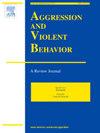儿童和青少年中皮质醇、睾酮和攻击性之间关系的系统综述
IF 3.4
2区 心理学
Q1 CRIMINOLOGY & PENOLOGY
引用次数: 0
摘要
侵略受到生物、心理和环境因素的影响,是一个重大的公共卫生问题。本文综述了激素对青少年攻击行为的影响,重点介绍了皮质醇和睾酮。采用PRISMA指南,我们系统地检索了主要数据库,以确定涉及儿童和青少年的相关研究。在符合纳入标准的79篇文章中,研究结果主要是非显著性或混合的。重要的结果表明睾酮和攻击性之间存在适度的相关性,特别是在青少年中。皮质醇表现出更复杂的模式,低皮质醇水平与青少年(尤其是男性)的攻击性增加有关,而对年幼儿童的研究结果则不那么确定。睾酮和皮质醇在攻击性方面的相互作用也各不相同;在青少年样本中,高睾酮和低皮质醇与攻击性增加有关。这些结果强调了荷尔蒙对攻击性的复杂影响,受年龄和性别的调节。观察到的青春期睾酮水平升高与攻击性之间的联系与睾酮在地位驱动行为中的作用一致。与双激素假说一致,睾酮对攻击性的影响似乎被皮质醇水平所缓和,这表明青春期是有针对性干预的关键时期。未来的研究应优先考虑纵向研究,以澄清这些关系,并进一步验证跨发育阶段的双激素假说。本文章由计算机程序翻译,如有差异,请以英文原文为准。
A systematic review of the relationship between cortisol, testosterone, and aggression in children and adolescents
Aggression, influenced by biological, psychological, and environmental factors, poses a significant public health concern. This paper reviews the hormonal influences on youth aggression, focusing on cortisol and testosterone. Employing PRISMA guidelines, we systematically searched major databases to identify relevant studies involving children and adolescents. Among the 79 articles that met the inclusion criteria, the findings were predominantly non-significant or mixed. Significant results suggest a modest correlation between testosterone and aggression specifically in adolescents. Cortisol demonstrated a more complex pattern, with low cortisol levels associated with increased aggression in adolescents, particularly in males, while findings in younger children were less conclusive. The interaction between testosterone and cortisol in relation to aggression also varied; high testosterone and low cortisol were linked to increased aggression in adolescent samples. These results highlight the intricate interplay of hormonal influences on aggression, modulated by age and sex. The observed association between elevated testosterone and aggression in adolescence aligns with testosterone's role in status-driven behaviors. Consistent with the dual-hormone hypothesis, the influence of testosterone on aggression appears to be moderated by cortisol levels, suggesting adolescence as a critical period for targeted interventions. Future research should prioritize longitudinal studies to clarify these relationships and further test the dual-hormone hypothesis across developmental stages.
求助全文
通过发布文献求助,成功后即可免费获取论文全文。
去求助
来源期刊

Aggression and Violent Behavior
Multiple-
CiteScore
7.50
自引率
4.30%
发文量
63
期刊介绍:
Aggression and Violent Behavior, A Review Journal is a multidisciplinary journal that publishes substantive and integrative reviews, as well as summary reports of innovative ongoing clinical research programs on a wide range of topics germane to the field of aggression and violent behavior. Papers encompass a large variety of issues, populations, and domains, including homicide (serial, spree, and mass murder: sexual homicide), sexual deviance and assault (rape, serial rape, child molestation, paraphilias), child and youth violence (firesetting, gang violence, juvenile sexual offending), family violence (child physical and sexual abuse, child neglect, incest, spouse and elder abuse), genetic predispositions, and the physiological basis of aggression.
 求助内容:
求助内容: 应助结果提醒方式:
应助结果提醒方式:


